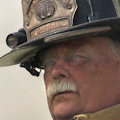I was having a discussion the other day with some members of a nearby department about increasing the flow and safe handling ability of their 2-1/2” preconnected line. The officers gathered about decided to replace their 100-PSI combination nozzle with a smooth bore that would operate more efficiently at a lower pressure, and would provide more flow while being a bit easier to handle due to reduced nozzle reaction forces.
So far, so good, but when it came time to determine the tip size, the discussion became somewhat derailed when someone suggested picking the nozzle bore based on what the big cities use.
I suggested that it might not be the right way to go about things. For example, if you decide to use the standard FDNY 1-1/8” nozzle, you can expect a flow rate of 266-GPM at 50-PSI, which will generate 99-lbs/force of reaction. Then, keep in mind that it is standard practice for the FDNY to team up two engine companies to operate a single 2-1/2” hose line that provides six firefighters and two officers to move the line and relieve each other.
Since this was a volunteer department, unless they get a hit on meeting night, chances are that they will have to operate their line with two or three firefighters.
If they wanted to reduce the reaction force, they could reduce the nozzle pressure to say, 45-PSI, which would still give them a 252-GPM stream with good reach and would reduce the reaction to 89-lbs/force.
On the other hand, if they evaluate the capabilities of the 1-1/4” tip (Chicago’s standard for those of you still determined to pick nozzle size by city) they would find that they could operate at 40-PSI nozzle pressure, flow 294-GPM and still have a stream with reach that is almost the same as the 1-1/8” nozzle flowing less water. The upside is that the nozzle would be generating 98 lbs/force of reaction, a pound less than the 1-1/8” tip while flowing 42-GPM more water.
One thing about large diameter smooth bores is that they can generate an effective stream beginning at about 35-PSI nozzle pressure. At that pressure, the 1-1/4” tip will deliver 275-GPM at 86 lbs/force reaction.
For those of you who started skimming the paragraphs when I started to talk about numbers, consider this:
Both the 1-1/8” and 1-1/4” smooth bores are excellent for use with a 2-1/2” hand line.
In practical use, the 1-1/8” tops out at about 279-GPM at 55-PSI nozzle pressure, while the 1-1/4” tip flows 344-GPM at the same pressure. Both streams are not easy to handle but by getting the line on the ground and applying pressure with your knee or butt, or by tying them off, they can be safely handled—with practice.
The bottom line is that for normal attack use, the 1-1/4” tip will supply more water at less nozzle reaction at very little loss in stream reach.
The other good news is that you probably have some 1-1/4” tips on your rig right now.
Dig out the set of stacked tips that someone in the past thought you had to have, and take off the two outside tips. You are left with a 1-1/4” high flow nozzle, complete with 1-1/2” threads on which you can attach a smaller line for when you knock down the main body of fire, and go offensive.
And, as an added bonus, the two tips you removed will make a dandy pencil holder on your desk—a good place for them.
